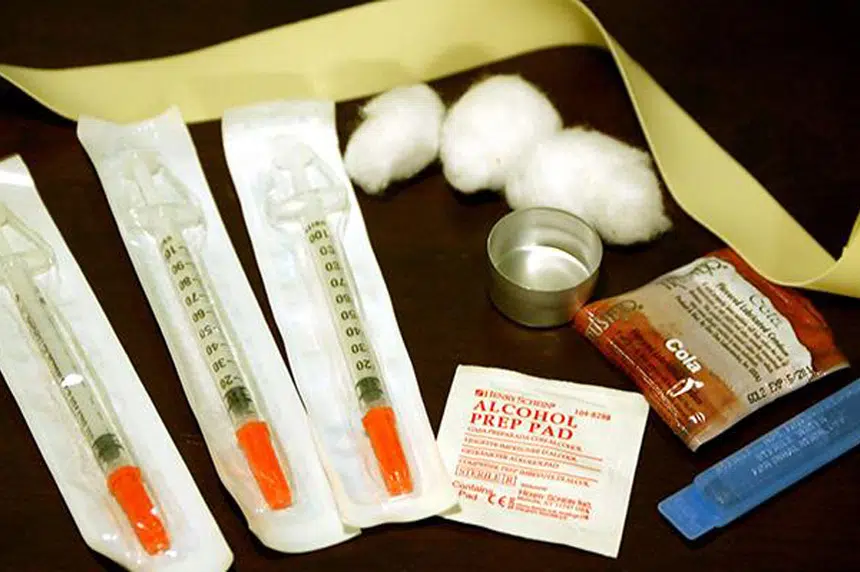Saskatchewan’s battle with deaths due to drug overdoses continued to worsen in the second month of 2021.
According to its most recent report, the Saskatchewan Coroners Service identified 39 additional deaths since its last update at the beginning of February. That amounts to 75 suspected or confirmed drug toxicity deaths since we turned the calendar.
Also included in the report is the confirmation from the service that Saskatchewan officially surpassed its worst year on record, with 233 confirmed overdose deaths recorded in 2020. The previous record was 177 in 2019.
With the statistics not being released by the provincial government — it’s the update of an online report by the coroners service — Prairie Harm Reduction executive director Jason Mercredi said it’s easy for these deaths to become “more broader stats.”
“They don’t become the people, the family and friends that are connected into the community,” he said Thursday morning.
“There’s that classic saying — ‘One death’s a tragedy and a thousand’s a stat’ — and that’s where we’re at. The government needs to start humanizing this issue. It can’t just be up to non-profits like ours.”
In an emailed statement, the Ministry of Health said the loss of any life to an overdose is a tragedy.
“(Each death) has an impact on families, friends, and communities as a whole. We express our deepest sympathies to those who have lost a loved one as a result of overdose,” the statement reads.
“Our government is committed to providing a continuum of mental health and addiction services that focus on prevention, awareness, harm reduction, education and treatment, including targeted interventions for opioids and crystal meth use.”
On Thursday, Mercredi said he isn’t sure if his safe consumption site will get funding to its previous ask of $1.3 million from the provincial government.
“We’re fairly hopeful. All we can do is go off the tone of the conversations,” he said. “The thing about us, if it’s a yes, we’d like to hear it. If it’s a no, we’d like to hear it.”
Mercredi also used a hockey-related analogy to describe how he feels the overdose death crisis is heading.
“The way I look at it, we’re in the first period and we’re down by five goals,” he said. “It’s going to take a very much team effort and grinding out a play-by-play win. In order for us to do that, everybody has to be on the same page.”
When he speaks of everybody, he is referencing other non-profit organizations, along with government programming.
“If we dig in on this, we can solve it. It’s not going to fix itself, that’s for sure,” he said.
“We need some leadership down in Regina on this file … We’re hopeful that we’re going to see something (on budget day) because we need the government to be commenting on this other than just, ‘Yeah, this is a tragedy.’ (We) need concrete steps to be taken to reverse what’s going on.”
When examining the numbers in the report, the confirmed overdose deaths have occurred in 53 Saskatchewan communities since 2020. That includes Regina (103 in 2020, six so far in 2021) and Saskatoon (56 in 2020, two in 2021).
Mercredi said when looking at the crisis as a whole, people need to also take a look at some of the smaller communities as well.
“We need some creative solutions to deal with the amount of deaths that are happening in rural Saskatchewan. We look at the list of communities across the province (where) people are passing away (and) it’s not good,” he said.
Of those 53 communities, 12 Indigenous communities were listed. The village of Tantallon was the smallest community on the confirmed overdose death list with a 2016 census population of just 91 citizens.
Also announced Thursday was a public safety concern in Regina of a dangerous concoction of drugs. The combination includes high levels of Xylazine, along with fentanyl, acetyl fentanyl and methamphetamine.
Xylazine is used by veterinarians to sedate large animals as a sedative, analgesic and muscle relaxant. It has drastic effects on the central nervous system causing blurred vision, disorientation, dizziness and drowsiness.
According to a release from the coroner’s service, at least four people in Regina have died due to the concoction since Feb. 14.
Queen City tops list of confirmed overdoses in Sask.
Regina isn’t just the capital city of Saskatchewan. It’s also the community leading the way in drug overdose deaths in the province.
As mentioned earlier, Regina is seeing nearly double the number of overdose deaths than its most comparable centre in Saskatoon. Regina has recorded 109 confirmed deaths since 2020, with Saskatoon at 58.
“The word ‘crisis’ really speaks for itself,” Regina Police Chief Evan Bray said Thursday.
Bray noted that although the two cities are comparable in some characteristics, there are also many that set the two apart. Examples of that include the crime rates, gangs and types of gangs.
When asked if the safe consumption site factors into the equation with the two figures, Bray erred on the side of caution.
“I don’t know that I’ve got data that really gives a definitive answer to that, one way or the other. Perhaps that does play a factor, although again I don’t know and I can’t say definitively that that’s the case,” he said.
“This drug problem has taken a unique persona in our city, and so I think it could be a variety of different things. That’s part of the work that’s happening right now. The provincial government is leading to try and understand why this challenging problem is happening in this community, and what to do to address it.”
 Bray added that so far in 2021, there have been more than 300 overdose calls in Regina. That works out to be around five per day, but those figures aren’t telling the whole story, the police chief said.
Bray added that so far in 2021, there have been more than 300 overdose calls in Regina. That works out to be around five per day, but those figures aren’t telling the whole story, the police chief said.
“We know that not all overdoses are reported to emergency services. So the number that we have in terms of how many have been reported is clearly lower than the actual experience in the community,” he said, before opening up more about what the Regina Police Service is seeing at the street level.
“One thing that we have noticed is we’ve seen a change in the type of drugs in the community. Meth has been a constant presence and problem for us in the city. Methamphetamine was responsible for a lot of the crime that we were seeing through 2017, 2018, 2019. Last year, meth continued to be a problem, but I would say fentanyl really took the driver’s seat in terms of the problems that we were seeing in the community.”
Bray added that over this past time period, worries have shifted from crime to being in a health crisis. He said fentanyl has had a devastating effect — police are seeing a “severe increase” on the streets of Regina — but the police service is working on some of the issues.
“There’s a lot of work that’s going on,” Bray said. “We continue to focus efforts on enforcement and suppression of these illicit and illegal drugs coming into our community. That’s only one part of the problem, but if we can make some meaningful change in how these drugs are coming into our community, people that are selling them, that’s part of the solution. But it really is only part of it.”
He said more work needs to be done to address those root causes of addiction, adding the province and the Saskatchewan Health Authority are also working on these issues. From inpatient to outpatient care to support services to access to treatment and therapy, work is being done.
“Truly, an addiction in its true form is a health crisis, and it is something that needs some substantial resource attention to make some change there,” he said, before adding there is room for harm reduction to be a part of the conversation.
“Whether it’s the rollout of naloxone to communities, to individuals, our police service … the prevalence of safety inhalation kits, needle exchange program, we’ve got a couple of applications that have been put forward right now for urgent needs public health sites — so basically, a safe consumption site. All of these efforts deal with the immediacy of the problem, while longer-term strategies to be put in place to hopefully, make some sustainable change.”











